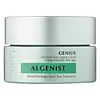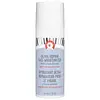What's inside
What's inside
 Key Ingredients
Key Ingredients

 Benefits
Benefits

 Concerns
Concerns

 Ingredients Side-by-side
Ingredients Side-by-side

Water
Skin ConditioningCaprylic/Capric Triglyceride
MaskingHydrogenated Polyisobutene
EmollientGlycerin
HumectantChlorella Protothecoides Oil
EmollientDimethicone
EmollientButylene Glycol
HumectantGlyceryl Stearate
EmollientPEG-100 Stearate
Butyrospermum Parkii Butter
Skin ConditioningPentylene Glycol
Skin ConditioningPotassium Cetyl Phosphate
EmulsifyingParachlorella Beijerinckii Exopolysaccharides
Skin ProtectingCollagen
MoisturisingCeramide NP
Skin ConditioningCynara Scolymus Leaf Extract
Skin ConditioningRetinyl Palmitate
Skin ConditioningAstragalus Membranaceus Root Extract
EmollientAtractylodes Macrocephala Root Extract
Skin ConditioningIris Florentina Root Extract
MaskingBupleurum Falcatum Root Extract
Skin ConditioningCopper Lysinate/Prolinate
Skin ConditioningMethylglucoside Phosphate
Skin ConditioningStearalkonium Bentonite
Gel FormingAcrylates/C10-30 Alkyl Acrylate Crosspolymer
Emulsion StabilisingSilica
AbrasiveCaprylyl Glycol
EmollientSodium Hydroxide
BufferingDisodium EDTA
Ethylhexylglycerin
Skin ConditioningCetyl Alcohol
EmollientPropylene Carbonate
SolventQuartz
AbrasivePhenoxyethanol
PreservativeLeuconostoc/Radish Root Ferment Filtrate
AntimicrobialChlorphenesin
AntimicrobialParfum
MaskingCoumarin
PerfumingWater, Caprylic/Capric Triglyceride, Hydrogenated Polyisobutene, Glycerin, Chlorella Protothecoides Oil, Dimethicone, Butylene Glycol, Glyceryl Stearate, PEG-100 Stearate, Butyrospermum Parkii Butter, Pentylene Glycol, Potassium Cetyl Phosphate, Parachlorella Beijerinckii Exopolysaccharides, Collagen, Ceramide NP, Cynara Scolymus Leaf Extract, Retinyl Palmitate, Astragalus Membranaceus Root Extract, Atractylodes Macrocephala Root Extract, Iris Florentina Root Extract, Bupleurum Falcatum Root Extract, Copper Lysinate/Prolinate, Methylglucoside Phosphate, Stearalkonium Bentonite, Acrylates/C10-30 Alkyl Acrylate Crosspolymer, Silica, Caprylyl Glycol, Sodium Hydroxide, Disodium EDTA, Ethylhexylglycerin, Cetyl Alcohol, Propylene Carbonate, Quartz, Phenoxyethanol, Leuconostoc/Radish Root Ferment Filtrate, Chlorphenesin, Parfum, Coumarin
Water
Skin ConditioningGlyceryl Stearate Se
EmulsifyingGlycerin
HumectantCaprylic/Capric Triglyceride
MaskingDimethicone
EmollientUrea
BufferingCetyl Alcohol
EmollientAvena Sativa Kernel Flour
AbrasiveSqualane
EmollientCaprylyl Glycol
EmollientButyrospermum Parkii Butter
Skin ConditioningAllantoin
Skin ConditioningPersea Gratissima Oil
Skin ConditioningN-Butyl Alcohol
PerfumingCarbomer
Emulsion StabilisingChrysanthemum Parthenium Extract
Skin ConditioningCamellia Sinensis Leaf Extract
AntimicrobialGlycyrrhiza Glabra Root Extract
BleachingSodium Hydroxide
BufferingCeramide NP
Skin ConditioningLeuconostoc/Radish Root Ferment Filtrate
AntimicrobialPhenoxyethanol
PreservativeTetrasodium EDTA
Water, Glyceryl Stearate Se, Glycerin, Caprylic/Capric Triglyceride, Dimethicone, Urea, Cetyl Alcohol, Avena Sativa Kernel Flour, Squalane, Caprylyl Glycol, Butyrospermum Parkii Butter, Allantoin, Persea Gratissima Oil, N-Butyl Alcohol, Carbomer, Chrysanthemum Parthenium Extract, Camellia Sinensis Leaf Extract, Glycyrrhiza Glabra Root Extract, Sodium Hydroxide, Ceramide NP, Leuconostoc/Radish Root Ferment Filtrate, Phenoxyethanol, Tetrasodium EDTA
 Reviews
Reviews

Ingredients Explained
These ingredients are found in both products.
Ingredients higher up in an ingredient list are typically present in a larger amount.
This ingredient is also known as shea butter. It is an effective skin hydrator and emollient.
Emollients help soothe and soften your skin. It does this by creating a protective film on your skin. This barrier helps trap moisture and keeps your skin hydrated. Emollients may be effective at treating dry or itchy skin.
Shea butter is rich in antioxidants. Antioxidants help fight free-radicals, or molecules that may harm the body. It is also full of fatty acids including stearic acid and linoleic acid. These acids help replenish the skin and keep skin moisturized.
While Shea Butter has an SPF rating of about 3-4, it is not a sunscreen replacement.
Shea butter may not be fungal acne safe. We recommend speaking with a professional if you have any concerns.
Learn more about Butyrospermum Parkii ButterThis ingredient is an emollient, solvent, and texture enhancer. It is considered a skin-softener by helping the skin prevent moisture loss.
It helps thicken a product's formula and makes it easier to spread by dissolving clumping compounds.
Caprylic Triglyceride is made by combining glycerin with coconut oil, forming a clear liquid.
While there is an assumption Caprylic Triglyceride can clog pores due to it being derived from coconut oil, there is no research supporting this.
Learn more about Caprylic/Capric TriglycerideCaprylyl Glycol is a humectant and emollient, meaning it attracts and preserves moisture.
It is a common ingredient in many products, especially those designed to hydrate skin. The primary benefits are retaining moisture, skin softening, and promoting a healthy skin barrier.
Though Caprylyl Glycol is an alcohol derived from fatty acids, it is not the kind that can dry out skin.
This ingredient is also used as a preservative to extend the life of products. It has slight antimicrobial properties.
Learn more about Caprylyl GlycolCeramide NP is a type of ceramide and formally known as ceramide 3.
Ceramides are intercellular lipids naturally found in our skin that bonds dead skin cells together to create a barrier. They are known for their ability to hold water and thus are a great ingredient for dry skin.
Ceramides are an important building block for our skin barrier. A stronger barrier helps the skin look more firm and hydrated. By bolstering the skin ceramides act as a barrier against irritating ingredients. This can help with inflammation as well.
If you would like to eat ceramides, sweet potatoes contain a small amount.
Read more about other common types of ceramides here:
Ceramide AP
Ceramide EOP
Cetyl Alcohol is a fatty alcohol. Fatty Alcohols are most often used as an emollient or to thicken a product.
Its main roles are:
Though it has "alcohol" in the name, it is not related to denatured alcohol or ethyl alcohol.
The FDA allows products labeled "alcohol-free" to have fatty alcohols.
Learn more about Cetyl AlcoholDimethicone is a type of synthetic silicone created from natural materials such as quartz.
What it does:
Dimethicone comes in different viscosities:
Depending on the viscosity, dimethicone has different properties.
Ingredients lists don't always show which type is used, so we recommend reaching out to the brand if you have questions about the viscosity.
This ingredient is unlikely to cause irritation because it does not get absorbed into skin. However, people with silicone allergies should be careful about using this ingredient.
Note: Dimethicone may contribute to pilling. This is because it is not oil or water soluble, so pilling may occur when layered with products. When mixed with heavy oils in a formula, the outcome is also quite greasy.
Learn more about DimethiconeGlycerin is already naturally found in your skin. It helps moisturize and protect your skin.
A study from 2016 found glycerin to be more effective as a humectant than AHAs and hyaluronic acid.
As a humectant, it helps the skin stay hydrated by pulling moisture to your skin. The low molecular weight of glycerin allows it to pull moisture into the deeper layers of your skin.
Hydrated skin improves your skin barrier; Your skin barrier helps protect against irritants and bacteria.
Glycerin has also been found to have antimicrobial and antiviral properties. Due to these properties, glycerin is often used in wound and burn treatments.
In cosmetics, glycerin is usually derived from plants such as soybean or palm. However, it can also be sourced from animals, such as tallow or animal fat.
This ingredient is organic, colorless, odorless, and non-toxic.
Glycerin is the name for this ingredient in American English. British English uses Glycerol/Glycerine.
Learn more about GlycerinLeuconostoc/Radish Root Ferment Filtrate is a natural preservative. It comes from fermenting radish roots with a bacteria called leuconostoc.
Leuconostoc comes from lactic acid.
This ingredient has antimicrobial properties and helps prevent the growth of bacteria in a product.
Leuconostoc is used to make the traditional Korean side-dish, kimchi. It is also used to make sourdough bread (both incredibly yummy foods).
Learn more about Leuconostoc/Radish Root Ferment FiltratePhenoxyethanol is a preservative that has germicide, antimicrobial, and aromatic properties. Studies show that phenoxyethanol can prevent microbial growth. By itself, it has a scent that is similar to that of a rose.
It's often used in formulations along with Caprylyl Glycol to preserve the shelf life of products.
Sodium Hydroxide is also known as lye or caustic soda. It is used to adjust the pH of products; many ingredients require a specific pH to be effective.
In small amounts, sodium hydroxide is considered safe to use. However, large amounts may cause chemical burns due to its high alkaline.
Your skin has a natural pH and acid mantle. This acid mantle helps prevent harmful bacteria from breaking through. The acid mantle also helps keep your skin hydrated.
"Alkaline" refers to a high pH level. A low pH level would be considered acidic.
Learn more about Sodium HydroxideWater. It's the most common cosmetic ingredient of all. You'll usually see it at the top of ingredient lists, meaning that it makes up the largest part of the product.
So why is it so popular? Water most often acts as a solvent - this means that it helps dissolve other ingredients into the formulation.
You'll also recognize water as that liquid we all need to stay alive. If you see this, drink a glass of water. Stay hydrated!
Learn more about Water